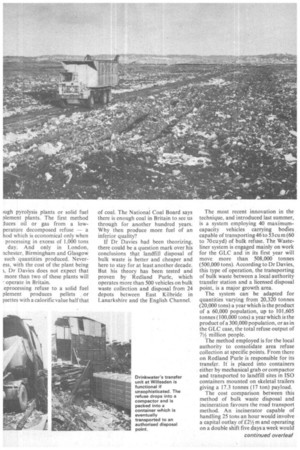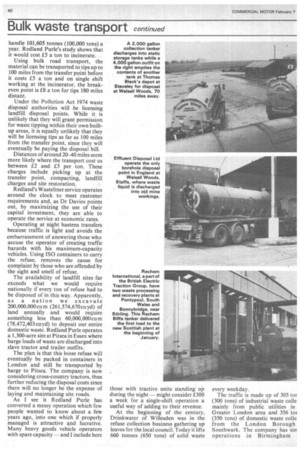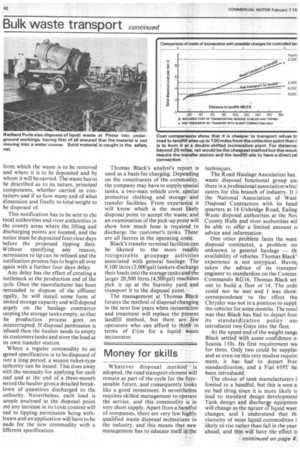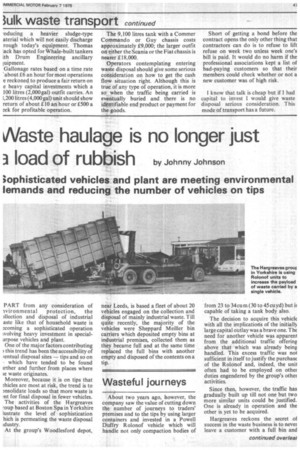A pot of gold at the en1 of the rubbish tii
Page 40

Page 41

Page 42

Page 43

Page 44

Page 49

If you've noticed an error in this article please click here to report it so we can fix it.
New opportunities are beginning to emerge via the Pollutio Act for hauliers who want to diversify into waste disposal
by lain Sheri
EVERY man, woman and child in Britain generates one-third of a ton of domestic refuse annually — and that adds up to a great deal of rubbish. In fact, it amounts to 20 million tons in total, 80 per cent of which is disposed of in landfill sites, 18 per cent is incinerated and 2 per cent is composted. ACcording to Dr David Davies, marketing director of Rediand Purle, this will be the pattern of things for the next 10 years at least.
Dr Davies advances strong arguments to support his claim that the bulk transport of refuse to landfill sites will at least be maintained at its present percentage and could be increased. This can only be good news for those who are engaged in bulk waste disposal.
He asks: "What are the alternatives?" Reclamation, incineration and reprocessing are the answers advanced by material conservationists and environmentalists alike.
Before looking at bulk waste disposal by landfill techniques, it will pay to look at the other possibilities. You may not agree with Dr Davies' arguments.
First of all, the reclamation method: this demands a degree of sorting at source by unskilled and very often unwilling householders. It has then to be transported to a sorting depot, separated optically and then magnetically into its various resaleable categories. Thereafter it has to be baled, stored, sold and eventually transported to the purchaser. All this makes reclamation domestic waste a highly labour inten. operation and consequently very co with no guaranteed market at the enc the operation. Dr Davies suggests flu is too risky to contemplate.
Incineration, according to Transport and Road Resea Laboratory report number 647 wt was issued in January, might prod suitable road-building material. Thei some doubt in the report and there scarcity of road-building material. incineration could not be justified that count alone. There are incinerators in operation in Britain 40 more at the planning stage; and n that local government spending been cut, they are likely to remain on drawing-board for some time.
Reprocessing waste can be dc iugh pyrolysis plants or solid fuel plement plants. The first method Juces oil or gas from a lowperature decomposed refuse — a hod which is economical only when processing in excess of 1,000 tons day. And only in London, nehester, Birmingham and Glasgow such quantities produced. Neveress, with the cost of the plant being 1, Dr Davies does not expect that more than two of these plants will operate in Britain.
eprocessing refuse to a solid fuel plement produces pellets _ or iuettes with a calorific value half that of coal. The National Coal Board says there is enough coal in Britain to see us through for another hundred years. Why then produce more fuel of an inferior quality?
If Dr Davies had been theorizing, there could be a question mark over his conclusions that landfill disposal of bulk waste is better and cheaper and here to stay for at least another decade. But his theory has been tested and proven by Redland Purle, which operates more than 500 vehicles on bulk waste collection and disposal from 24 depots between East !Clavicle in Lanarkshire and the English Channel. The most recent innovation in the technique, and introduced last summer, is a system employing 40 maximumcapacity vehicles carrying bodies capable of transporting 46 to 53 cu m (60 to 70 cu yd) of bulk refuse. The Wasteliner system is engaged mainly on work for the GLC and in its first year will move more than 508,000 tonnes (500,000 tons). According to Dr Davies, this type of operation, the transporting of bulk waste between a local authority transfer station and a licensed disposal point, is a major growth area.
The system can be adapted for quantities varying from 20,320 tonnes (20,000 tons) a year which is the product of a 60,000 population, up to 101,605 tonnes (100,000 tons) a year which is the product of a 300,000 population, or as in the GLC case, the total refuse output of 7V2 million people.
The method employed is for the local authority to consolidate area refuse collection at specific points. From there on Redland Purle is responsible for its transfer. It is placed into containers either by mechanical grab or compactor and transported to landfill sites in ISO containers mounted on skeletal trailers giving a 17.3 tonnes (17 ton) payload.
The cost comparison between this method of bulk waste disposal and incineration favours the road transport method. An incinerator capable of handling 25 tons an hour would involve a capital outlay of £21/4 m and operating on a double shift five days a week would handle 101,605 tonnes (100,000 tons) a year. Redland Purle's study shows that it would cost £5 a ton to incinerate.
Using bulk road transport, the material can be transported to tips up to 100 miles from the transfer point before it costs £5 a ton and on single shift working at the incinerator, the breakeven point is £8 a ton for tips 180 miles distant.
Under the Pollution Act 1974 waste disposal authorities will be licensing landfill disposal points. While it is unlikely that they will grant permission for waste tipping within their own built up areas, it is equally unlikely that they will be licensing tips as far as 100 miles from the transfer point, since they will eventually be paying the disposal bill.
Distances of around 20-40 miles seem more likely where the transport cost us between £2 and £3 per ton. These charges include picking up at the transfer point, compacting, landfill charges and site restoration.
Red land's Wasteliner service operates around the clock to meet customer requirements and, as Dr Davies points out, by maximizing the use of their capital investment, they are able to operate the service at economic rates.
Operating at night hastens transfers because traffic is light and avoids the embarrassment of answering those who accuse the operator of creating traffic hazards with his maximum-capacity vehicles. Using ISO containers to carry the refuse, removes the cause for complaint by those who are offended by the sight and smell of refuse.
The availability of landfill sites far exceeds what we would require nationally if every ton of refuse had to be disposed of in this way. Apparently, as a nation we excavate 200,000,000 cu m (261,574,670 cu yd) of land annually and would require something less than 60,000,000 cum (78,472,403 cuyd) to deposit our entire domestic waste. Redland Purle operates a 1,300-acre site at Pitsea in Essex where barge loads of waste are discharged into slave tractor and trailer outfits.
The plan is that this loose refuse will eventually be packed in containers in London and still be transported by barge to Pitsea. The company is now considering cross-country tractors, thus further reducing the disposal costs since there will no longer be the expense of laying and maintaining site roads.
As I see it Redland Purle has converted a messy operation which few people wanted to know about a few years ago, into one which if properly managed is attractive and lucrative.
Many heavy goods vehicle operators with spare capacity and I include here those with tractive units standing up during the night — might consider £300 a week for a single-shift operation a useful way of adding to their revenue. At the beginning of the century, Drinkwater of Willesden was in the refuse collection business gathering up leaves for the local council. Today it lifts 660 tonnes (650 tons) of solid waste every weekday.
The traffic is made up of 305 tor (300 tons) of industrial waste colle mainly from public utilities in Greater London area and 356 toi (350 tons) of domestic waste colle from the London Borough Southwark. The company has sin operations in Birmingham London Mr Ron Ricketts, the .pany's transport manager, operates 'elides with 250 containers varying ze from 3.8 to 57 cum (5 to 75 cu yd). s common practice throughout the waste disposal business, Drink!r's customers are charged on the iber of lifts and on their distance a the disposal point. Tonnage is not ■ nsideration, strictly because refuse ;ht related to density varies between [modifies and conditions. For nple, paper can double in weight veen a wet and a dry state.
here are four distinct categories in Drinkwater operation, twelve 20F odens and eighty 23 cu m (30 cu yd) tainers which compact to 57 cu m ..:uyd) collect waste from industrial commercial customers around the ater London area and into the ges of the Home Counties. The ides leave the depot at Dudden Hill e, Willesden, at the beginning of the with an empty box. The box is laid at at the first site and a full box d. This is transported to the nearest torized disposal point where it is tied and then taken on to the next omer.
lepending on the location of the tomers to the tips, one man can lifi, aty and redeliver between four and m boxes each day.
)rinkwater uses tips own,..] and rated by other organizations. It is that this allows the company ximum flexibility in operation since 3uld not be sure of always acquiring awn tip close to a customer collection nt.
)rinkwater's drivers, who can earn to £70 a week, work a job-and-finish ius system which, according to Mr kelts, operates extremely well. The ius system and method of charging common to all the Drinkwater rations.
'he second operation employs three lens with Dumpmaster bodies !rating on a public utility contract two "milk-round collection (ices" to commercial premises within 5-mile radius of base. This is regular rk for contracted customers and ual inquiries are few and far between.
..three vehicles collect the contents of 4.6m (105 x 5 yd) bins, some once a :lc, others twice a week and still more, a daily basis.
he company's third operation is ding its own transfer point with three dge Dempster skip loaders with 77 ps. Refuse is collected from factories shopping precincts within seven es of base and carried to the• Ilesden depot where it is discharged into a hopper arrangement, fed into a static compaction unit and then packed into a 27 m (30 yd) container. The empty skip is taken to the next customer to replace a full one.
The transfer material is collected each morning by one of the Fodens and transported to a disposal point and begins the operation described earlier.
The fourth operation is a straightforward lift and tip for the London Borough of Southwark. At its Manor Place depot the local authority loads seven maximum-capacity vehicles with a mechanical grab — the bodies are 31 Cu m (40 cu yd). Material is transported 20 miles into Kent and discharged on an open tip on the edge of the Garden of England.
Drinkwater's policy of concentrating on collection and disposal without becoming involved in either owning disposal points or operating recycling equipment has relieved its resources to develop collection and compaction techniques. The chairman, Mr-Colin Drinkwater, was a pioneer in the development of compaction systems. Today the company markets, repairs and services an American compaction tool in this country — the Tricity.
Liquid waste disposal is another and possibly the largest transport growth area. This is not only because almost every industry in the country increases its poisonous waste output annually but because there is already in existence an incalculable amount of effluent which is being disposed of illegally. As the Disposal of Poisonous Waste Act 1972 is applied and enforced this effluent will have to be transported either to landfill sites or incinerators, and this will mean a substantial increase in road tanker traffic.
There is already more liquid waste of a notifiable nature in the country than there are transport facilities to dispose of it. Notifiable waste is defined in the Act as waste which is poisonous, noxious or polluting which, when deposited, can subject persons or animals to material risk of death, injury or impairment of health.
The Act was drafted following the cyanide dumping exposure in 1972 but it must not be thought that all notifiable wastes are in the cyanide category. Common waste such as used oil, stripped varnish or paint or commodities with low flash points, all come into the notifiable category.
The disposal technique is an entirely new and developing science in which fewer than 150 haulage contractors are at this moment involved. There is scope for many more, either using existing capital equipment modified for the work or new equipment to/ replace general haulage vehicles wkiCh are out of service.
One of the leading liquid disposal specialists is Thomas Black Ltd, of Staveley, a subsidiary of the Boddy group. After 21/2 years of operation the company is moving 4t6 m litres (approx one million gallons) of effluent a month between industry and disposal points, sometimes via its own transfer station, with 17 vehicles in central England. One of Thomas Black's biggest headaches is in finding authorized disposal points close to the pick-up point. It is not uncommon for a. 18,200 litre (4,000gal) load to be carried over 100 miles before discharging.
Disposal points, which have to be approved by local authorities, are few and• far between. This long-haul operation makes waste disposal more 'costly than it should be and even where tips are avialable it costs between £6 and £10 for 4,546 litres (approx 1,000gal) to discharge the load, but that is the end of the tale. There are many more problems to be overcome even before the waste, is lifted.
Until the 1972 Act industry discharged its effluent into main drainage, underground workings and rivers. Even today this practice goes on almost unchecked.
The first task of the waste disposal contractor is to show factory management that its effluent is poisonous and to do this Thomas Black takes samples of the material to a public analyst. The analyst's report is returned to the potential customer together with a rate for its disposal, and provided the potential customer can be convinced that legitimate disposal if preferable to the £400 fine which the Act allows for, then the first hurdle has been overcome.
The next stage is to find a disposal point willing to accept the waste. Although the responsibility rests on the customer to notify the local authority and the water authority of its intention to discharge the efauent at a licensed tip in its area, established contractors like Thomas Black have taken in hand the notifying procedure.
The notice of intention to remove and deposit the waste is a requirement under Section 3 of the Act and the notification must state clearly the name and address of the person giving the notice, the name and address of the premises from which the waste is to be removed and where it is to be deposited and by whom it will be carried. The waste has to be described as to its nature, principal components, whether carried in containers and if so how many and of what dimension and finally to total weight to be disposed of.
This notification has to be sent to the local authorities and river authorities in the county areas where the lifting and discharging points are located, and the notice must be deposited four clear days before the proposed tipping date. Without specifying any reason, permission to tip can be refused and the aotification process has to begin all over igain with a further four days delay.
Any delay has the effect of creating a bottleneck at the production end of the :lycle. Once the manufacturer has been persuaded to dispose of the effluent egally, he will install some form of imited storage capacity and will depend argely on the haulage contractor ceeping the storage tanks empty, so that .he production process goes on minterrupted. If disposal permission is .efused then the haulier needs to empty is customers tanks and store the load at us own transfer station.
Where a regular commodity to an igreed specification is to be disposed of wer a long period, a season ticket-type iuthority can be issued. This does away vith the necessity for applying for each oad and at the end of a three-month nriod the haulier gives a detailed breaklown of quantities discharged to the iuthority. Nevertheless, each load is ample analysed at the disposal point aid any increase in its toxic content will ead to tipping permission being withPrawn and an application will have to be nade for the new commodity with a lifferent specification. Thomas Black's analyst's report is used as a basis for charging. Depending on the constituents of the commodity, the company may have to supply special tanks, a two-man vehicle crew, special protective clothing and storage and transfer facilities. From experience it will know which is the most likely disposal point to accept the waste, and an examination of the pick-up point will show how much hose is required to discharge the customer's tanks. These are all factors in the operating costs.
Black's transfer terminal facilities can be likened to the more readily recognizable groupage activities associated with general haulage. The 9,100 litres (2,000 gal) tankers discharge their loads into the storage tanks and the larger 20,500 litres (4,500gal) machines pick it up at the Staveley yard and transport it to the disposal point.
The management at Thomas Black forsees the method of disposal changing in the next few years when incineration and treatment will replace the present landfill method, but there are few operators who can afford to think in terms of VAm for a liquid waste incinerator.
Whatever disposal method is adopted, the road transport element will remain as part of the cycle for the foreseeable future, and consequently looks like a good investment. It nevertheless requires skilled management to operate the service, and this commodity is in very short supply. Apart from a handful of companies, there are very few highly qualified waste disposal technicians in the industry, and this means that new management has to educate itself in the techniques.
The Road Haulage Association has . waste disposal functional group am there is a professional association whicl caters for this branch of industry. It i the National Association of Wast Disposal Contractors with its head quarters at 14 Uxbridge Road, Ealing Waste disposal authorities at the Nei; County Halls and river authorities wil be able to offer a limited amount o advice and information.
One other problem faces the wast disposal contractor, a problem no unknown in general haulage — th, availability of vehicles. Thomas Black' experience is not untypical. Havini taken the advice of its transpor engineer to standardize on the Comme Commando RG16, Thomas Black set. out to build a fleet of 14. The orde could not be met and I was show correspondence to the effect tha Chrysler was not in a position to suppi. the vehicles for some months. The resui was that Black has had to depart fron its standardization policy am introduced two Guys into the fleet.
At the upper end of the weight rangt Black settled with some confidence o. Scania 110s. Its first requirement wa for three. Only two could be supplie, and so even on this very modest require ment, it has had to depart &on standardization, and a Fiat 619T ha been introduced.
The choice of tank manufacturers i limited to a handful, but this is seen a no bad thing since it is more likely t( lead to standard design development Tank design and discharge equipmen will change as the nature oT liquid wast changes, and I understand that th, viscocity of most liquid commodities i likely to rise rather than fall in the year ahead, and this will have the effect o .oducing a heavier sludge-type aterial which will not easily discharge rough today's equipment. Thomas Lack has opted for Whale-built tankers ith Drum Engineering ancillary luipment.
Gallonage rates based on a time rate about £6 an hour for most operations e reckoned to produce a fair return on e heavy capital investments which a 100 litres (2,000 gal) outfit carries. An ,200 litres (4,000 gal) unit should show return of about £10 an hour or £500 a eek for profitable operation. The 9,100 litres tank with a Commer Commando or Guy chassis costs approximately £9,000; the larger outfit on either the Scania or the Fiat chassis is nearer £18,000.
Operators contemplating entering waste disposal should give some serious consideration on how to get the cash flow situation right. Although this is true of any type of operation, it is more so when the traffic being carried is eventually buried and there is no identifiable end product or payment for the goods. Short of getting a bond before the contract opens the only other thing that contractors can do is to refuse to lift refuse on week two unless week one's bill is paid. It would do no harm if the professional associations kept a list of bad-paying customers so that their members could check whether or not a new customer was of high risk.
I know that talk is cheap but if I had capital to invest I would give waste disposal serious consideration. This mode of transport has a future.












































































































































